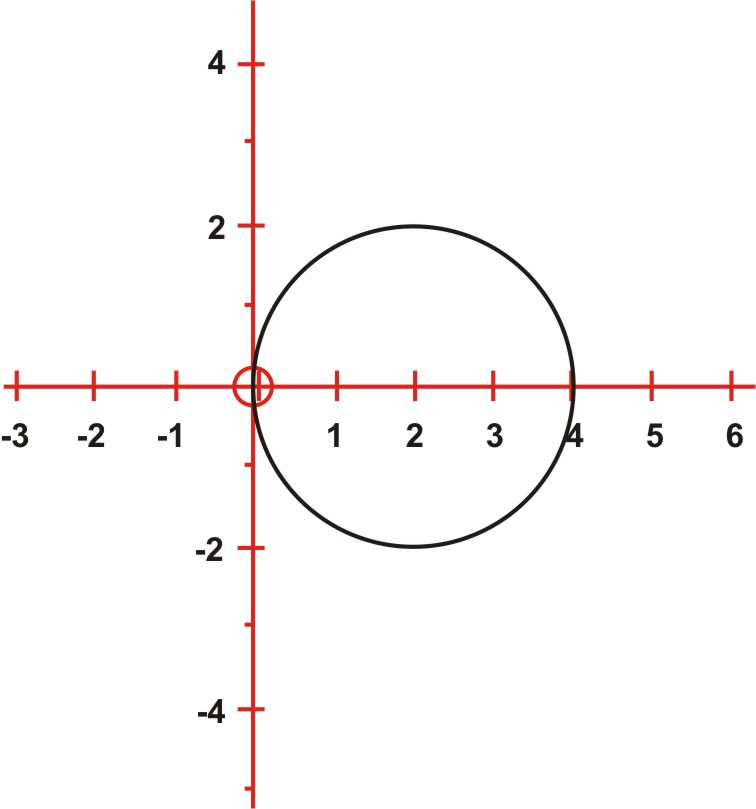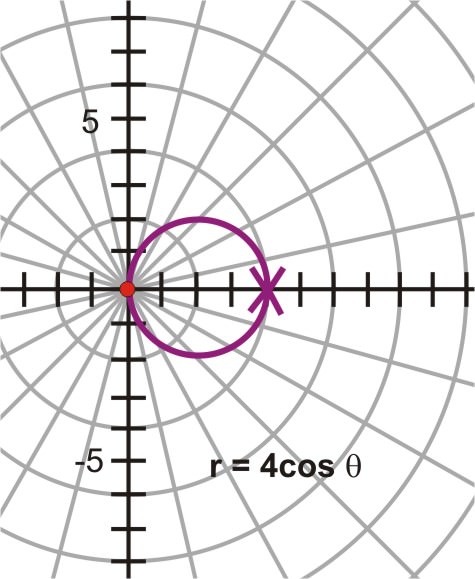5.2.3: Forma rectangular a polar para ecuaciones
( \newcommand{\kernel}{\mathrm{null}\,}\)
Convierte ecuaciones sustituyendo x e y con expresiones de distancia y ángulos.
Estás trabajando diligentemente en tu clase de matemáticas cuando tu profesor te da una ecuación para graficar:
(x+1)2−(y+2)2=7
A medida que comienzas a considerar cómo reorganizar esta ecuación, te dicen que el objetivo de la clase es convertir la ecuación a forma polar en lugar de forma rectangular.
¿Puedes encontrar la manera de hacer esto?
Ecuaciones rectangulares a la forma polar
Curiosamente, un sistema de coordenadas rectangulares no es la única forma de trazar valores. Un sistema polar puede ser útil. Sin embargo, a menudo ocurrirá que hay una o más ecuaciones que necesitan ser convertidas de forma rectangular a polar. Para escribir una ecuación rectangular en forma polar, sey=rsinθ utilizan las ecuaciones de conversión dex=rcosθ y.
Si la gráfica de la ecuación polar es la misma que la gráfica de la ecuación rectangular, entonces la conversión se ha determinado correctamente.

(x−2)2+y2=4

La ecuación rectangular(x−2)2+y2=4 representa un círculo con centro(2,0) y un radio de 2 unidades. La ecuación polarr=4cosθ es un círculo con centro(2,0) y un radio de 2 unidades.
Conversión de ecuaciones
1. Escribe la ecuación rectangularx2+y2=2x en forma polar.
Recuerdar=√x2+y2,r2=x2+y2 yx=rcosθ.
x2+y2=2xr2=2(rcosθ)Pythagorean Theorem r2=2rcosθr=2cosθandx=rcosθDivide each side by r
2. Escribir(x−2)2+y2=4 en forma polar.
Recuerdax=rcosθ yy=rsinθ.
\ (\ begin {alineado} (x-2) ^ {2} +y^ {2} &=4\\ (r\ cos\ theta-2) ^ {2} + (r\ sin\ theta) ^ {2} &=4 && x=r\ cos\ theta\ text {y} y=r\ sin\ theta\ r^ {2}\ cos ^ {2}\ theta eta-4 r\ cos\ theta+4+r^ {2}\ sin ^ {2}\ theta&=4 &&\ text {expandir los términos}\\ r^ {2}\ cos ^ {2}\ theta-4 r\ cos\ theta+r^ {2}\ sin ^ { 2}\ theta&=0 &&\ text {restar 4 de cada lado}\\ r^ {2}\ cos ^ {2}\ theta+r^ {2}\ sin ^ {2}\ theta&=4 r\ cos\ theta &&\ text {aislar los términos cuadrados}\\ r^ {2}\ left (\ cos ^ {2}\ theta+\ sin ^ {2}\ theta\ derecha) &=4 r\ cos\ theta &&\ texto {factor} r^ {2}\ texto {-a factor común}\\
r^ {2} &=4 r\ cos\ theta &&\ text {Identidad pitagórica}\\ r&=4\ cos\ theta &&\ text {Divide cada lado por} r\ end {alineado}\)
3. Escribe la ecuación rectangular(x+4)2+(y−1)2=17 en forma polar.
(x+4)2+(y−1)2=17(rcosθ+4)2+(rsinθ−1)2=17x=rcosθ and y=rsinθr2cos2θ+8rcosθ+16+r2sin2θ−2rsinθ+1=17 expand the termsr2cos2θ+8rcosθ−2rsinθ+r2sin2θ=0 subtract 17 from each sider2cos2θ+r2sin2θ=−8rcosθ+2rsinθisolate the squared termsr2(cos2θ+sin2θ)=−2r(4cosθ−sinθ) factor r2-a common factorr2=−2r(4cosθ−sinθ) Pythagorean Identityr=−2(4cosθ−sinθ) Divide each side by r
Anteriormente, se le pidió convertir una ecuación a forma polar.
Solución
La ecuación original a convertir es:
(x+1)2−(y+2)2=7
Se puede sustituirx=rcosθ yy=rsinθ en la ecuación, y luego simplificar:
\ (\ comenzar {alineado}
(r\ cos\ theta+1) ^ {2} - (r\ sin\ theta+2) ^ {2} &=7\\
\ izquierda (r^ {2}\ cos ^ {2}\ theta+2 r\ cos\ theta+1\ derecha) -\ izquierda (r^ {2}\ sin ^ {2}\ theta+4 r\ sin\ theta+4\ derecha) &=7\\
r^ {2}\ izquierda (\ cos ^ {2}\ theta-\ sin ^ {2}\ theta\ derecha) +2 r (\ cos\ theta-2\ sin\ theta) -3&=7\\
r^ {2}\ izquierda (\ cos ^ {2}\ theta-\ sin ^ {2}\ theta\ derecha) +2 r (\ cos\ theta-2\ sin\ theta) &=10
\ end {alineado}\)
Escribe la ecuación rectangular(x−4)2+(y−3)2=25 en forma polar.
Solución
\ (\ begin {alineado}
(x-4) ^ {2} + (y-3) ^ {2} &=25\\
x^ {2} -8 x+16+y^ {2} -6 y+9 &=25\\
x^ {2} -8 x+y^ {2} -6 y+25 &=25\\
x^ {2} -8 x+y^ {2} -6 y &=0\\
x^ {2} +y^ {2} -8 x-6 y &=0\\
r^ {2} -8 (r\ cos\ theta) -6 (r\ sin\ theta) &=0\\
r^ {2} -8 r\ cos\ theta-6 r\ sin\ theta &=0\\
r (r-8\ cos\ theta-6\ sin\ theta) &=0\
r=0\ texto {o} r-8\ cos\ theta-6\ sin\ theta &=0\
r=0\ texto {o} r &=8 cos\ theta+6\ sin\ theta
\ fin {alineado}\)
Al graficar r−8\ cos\ theta−6\ sin\ theta=0, vemos que las soluciones adicionales son 0 y 8.
Escribe la ecuación rectangular3x−2y=1 en forma polar.
Solución
3x−2y=13rcosθ−2rsinθ=1r(3cosθ−2sinθ)=1r=13cosθ−2sinθ
Escribe la ecuación rectangularx2+y2−4x+2y=0 en forma polar.
Solución
\ (\ begin {alineado}
x^ {2} +y^ {2} -4 x+2 y &=0\\
r^ {2}\ cos ^ {2}\ theta+r^ {2}\ sin ^ {2}\ theta-4 r\ cos\ theta+2 r\ sin\ theta &=0\\
r^ {2}\ izquierda (\ sin ^ {2}\ theta+2 r\ sin\ theta a+\ cos ^ {2}\ theta\ derecha) -4 r\ cos\ theta+2 r\ sin\ theta &=0\\
r (r-4\ cos\ theta+2\ sin\ theta) &=0\\
r=0\ texto {o} r-4\ cos\ theta+2\ sin\ theta &=0\\
r=0\ texto {o} r &=4\ cos\ theta-2\ sin\ theta
\ end {alineado}\)
Revisar
Escribe cada ecuación rectangular en forma polar.
- x=3
- y=4
- x2+y2=4
- x2+y2=9
- (x−1)2+y2=1
- (x−2)2+(y−3)2=13
- (x−1)2+(y−3)2=10
- (x+2)2+(y+2)2=8
- (x+5)2+(y−1)2=26
- x2+(y−6)2=36
- x2+(y+2)2=4
- 2x+5y=11
- 4x−7y=10
- x+5y=8
- 3x−4y=15
Reseña (Respuestas)
Para ver las respuestas de Revisar, abra este archivo PDF y busque la sección 6.6.


